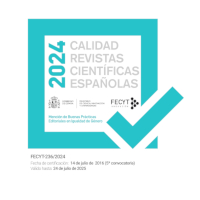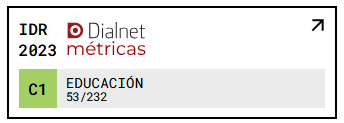Impact of multimodality in reading comprehension of narrative texts in English as a foreign language (EFL) in undergraduate students
DOI:
https://doi.org/10.18172/con.2608Keywords:
Foreign language learning, multimodality, narrative texts, reading comprehension.Abstract
This research seeks to compare the effect that monomodal and multimodal tests have on the reading comprehension level of English-written narrative texts that EFL learners achieve at a private Chilean university. For this purpose, a quasi-experiment was performed, using a monomodal reading comprehension test and another multimodal one, with intact groups. The experimental group took the multimodal format test, while the control group took the monomodal format test. The interest of this research focused on the need to integrate multimodal texts in L2 reading comprehension. The results endorse the hypothesis that students reach higher comprehension levels in multimodal reading comprehension tests.
Downloads
References
ALBERS, P. (2007). Visual discourse analysis: An introduction to the analysis of school-generated visual texts. En D. W. Rowe, R. T. Jiménez, D. L. Compton, D. K. Dickinson, Y. Kim, K. M. Leander, y V. J. Risko (Eds.), 56th yearbook of the National Reading Conference (pp. 81-95).
AUSUBEL, D., NOVAK, J. y HANESIAN, H. (2005). Psicología educativa. Un punto de vista cognoscitivo. México, D.F.: Trillas.
BARNETT, M. A. (1989). More than meets the eye: Foreign language reading. NJ: Pretince Hall.
BERNHARDT, E. B. (1983). Testing foreign language reading comprehension. The immediate recall protocol. Die Unterrichichtspraxis, 16, 27-33.
BERNHARDT, E. B. (1991). Reading development in a second-language. Norwood, NJ: Ablex.
CARREL, P. L. y CARSON, J. G. (1997). Extensive and intensive reading in an EAP setting. English for Specific Purposes, 16, 47-60.
CHUN, D. y PLASS, J. (1996). Facilitating Reading comprehension with multimedia. System, 24(4), pp. 503-519.
GEE, J. P. (2007). What video games have to teach us about learning and literacy. (Rev. ed.). Nueva York: Palgrave Macmillan.
HAMPEL, R. (2002). Network-based language teaching today: Multimodality, multi-dimensionality and interaction. Proceedings of the International Conference on Computers in Education (ICCE’02). The Open University, UK. Disponible en: http://csdl2.computer.org/comp/proceedings/icce/2002/1509/00/15090639.pdf.
HOSENFELD, C. (1979). A learning-teaching view of second language acquisition. Foreign Language Annals, 12, 51-54.
JEWITT, C. y KRESS, G. (2003). Multimodal literacy. Nueva York: Peter Lang.
KODA, K. (1994). Second language reading research: problems and possibilities. Applied Psycholinguistics, 15, 1-28.
KRESS, G. (2003). Literacy in the New Media Age. Cambridge: The Cromwell Press.
KRESS, G. y VAN LEEUWEN, T. (2001.) Multimodal Discourse. Londres: Arnold.
LAUFER, B. (1986). Possible changes in attitude towards vocabulary acquisition research. International Review of Applied Linguistics, 24(1), 69-75.
MATTHEWMAN, S., BLIGHT, A. y DAVIES, C. (2004). What does multimodality mean for English? Creative tensions in teaching new texts and new literacies. Education, Communication and Information, 4(1). Disponible en: http://www.interactiveeducation.ac.uk/out_mat.pdf.
MAYER, R. y SIMS, V. K. (1994). For whom is a picture worth a thousand words? Extensions of dual coding theory of multimedia learning. Journal of Educational Psychology, 86(3), 389-401.
PALINCSAR, A. S. y BROWN, A. L. (1984). Reciprocal teaching of comprehension-fostering and comprehension-monitoring activities. Cognition and Instruction, 1, 117-175.
RODRÍGUEZ, W., OCHOA, S. y PARKER, R. (2006). The crosslinguistic role of cognitive academic language proficiency on reading growth in Spanish and English. Bilingual Research Journal, 30. Disponible en: http://brj.asu.edu/vol30_no1/art5.pdf.
SCHOONEN, R., HULSTIJN, J. y BOSSERS, B. (1998). Metacognitive and language specific knowledge in native and foreign language reading comprehension: An empirical study among Dutch students in grades 6, 8 and 10. Language Learning, 48, 71-106.
SERAFINI, F. (2011). Expanding perspectives for comprehending visual images in multimodal texts. Journal of Adolescent and Adult Literacy, 54, 342-350.
SERAFINI, F. (2012). Expanding the four resources model: Reading visual and multimodal texts. Pedagogies: An International Journal, 7(2), 150-164.
SUSSER, B. y ROBB, TH. (1990). EFL extensive reading instruction: Research and procedure. JALT Journal, 12(2). Disponible en: http://www.cc.kyoto-su.ac.jp/~trobb/sussrobb.html.
WIDDOWSON, H. G. (1978). Teaching language as communication. Oxford: Oxford University Press.
WILLOWS, D. M. y HOUGHTON, H. A. (1987). The Psychology of illustration. Nueva York: Springer.
Downloads
Published
How to Cite
Issue
Section
License
The authors retain copyright of articles and authorize Contextos Educativos. Revista de Educación the first publication. They are free to share and redistribute the article without obtaining permission from the publisher as long as they give appropriate credit to the editor and the journal.
Self-archiving is allowed too. In fact, it is recommendable to deposit a PDF version of the paper in academic and/or institutional repositories.












